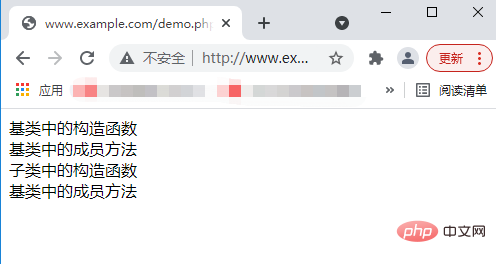
In the previous article, I brought you "Take you to distinguish the constructor and destructor in the class", which gave you in detail how to use it in the PHP class. Using constructors and destructors, in this article we will continue to look at the inheritance-related knowledge of PHP classes. I hope it will be helpful to everyone!

In PHP's object-oriented world, we can inherit an existing class through a class. The inherited class is called the parent class or base class. This class of the parent class is called a subclass. In fact, a subclass can be understood as an extension of the parent class, and the subclass can add new functions beyond those of the parent class. Subclasses can also inherit the constructor of the parent class. When the subclass is instantiated, PHP will first call the constructor in the subclass. When the subclass does not exist, it will call the constructor of the parent class.
extendsInherit keyword
In PHP, We implement class inheritance through theextendskeyword. Its syntax is as follows:
class 子类名 extends 父类名{ ... ... }
What we need to note is that a class can only inherit from another class, but a class can inherit multiple classes. That is, a subclass can only have one parent class, but a parent class can have multiple subclasses.
InheritancepublicMembers
In PHP, all parent classes usepublicModified members can be inherited by subclasses.
Next let’s take a look at an example. The example is as follows:
'; } public function demo(){ echo '基类中的成员方法
'; } } class son1 extends father{ } class son2 extends father{ public function __construct(){ echo '子类中的构造函数
'; } } $object = new son1(); $object -> demo(); $object2 = new son2(); $object2 -> demo(); ?>
Output result:

In the above example , define a base class, use another class to inherit this base class, and at the same time try to use the subclass to call member methods in the base class. As a result, all public-modified members of the parent class can be inherited by the subclass.
InheritprotectedMembers
In the above we talked about inheriting members modified bypublic, All can be inherited by subclasses. There is also aprotectedmember. The member modified by it is a member that does not want to be accessed from outside the class. It can be understood that by modifying this member, it is a protected member and can only be accessed by the class. is accessed internally, and can also be accessed internally within the subclass. We can set a member function in the subclass to access this member.
The example is as follows:
'; } protected function demo(){ echo '基类中的成员方法
'; } } class son1 extends father{ } class son2 extends father{ public function __construct(){ echo '子类中的构造函数
'; } public function test(){ $this -> demo(); } } $object = new son1(); // $object -> demo(); // 在子类中调用父类使用 protected 修饰的成员方法会报错 $object2 = new son2(); $object2 -> test(); ?>
Output result:

We can see from the above example that through protected Modified variables can also be accessed within inherited subclasses.
InheritanceprivateMembers
In PHP classes, members modified byprivatecannot be accessed outside the class, nor can they be accessed by subclasses. It can be understood that this is the private modification. Class private members. To be precise, members modified by private are not inherited by subclasses, and naturally cannot be accessed by subclasses.
The example is as follows:
'; } } class son extends father{ public function test(){ $this -> demo(); } } $object = new son(); $object -> test(); ?>
The output result is wrong. When a member modified with the private keyword in the parent class is called in the subclass, the program will report an error and terminate the operation.
If you are interested, you can click on "PHP Video Tutorial" to learn more about PHP knowledge.
The above is the detailed content of How to get PHP class inheritance? (Summary sharing). For more information, please follow other related articles on the PHP Chinese website!